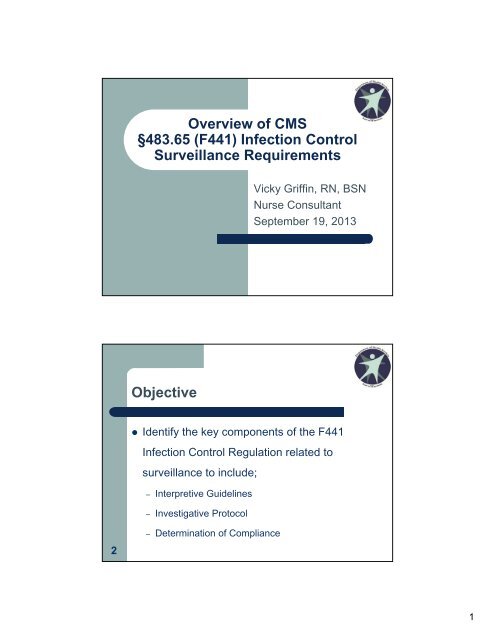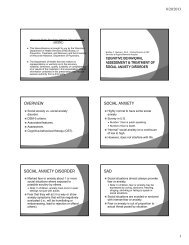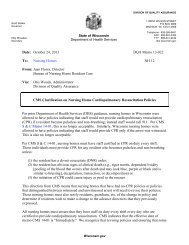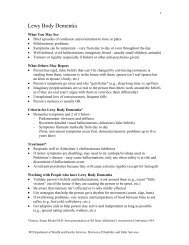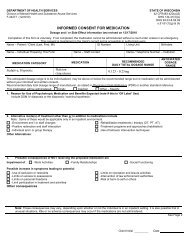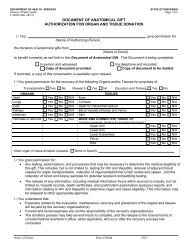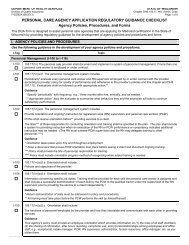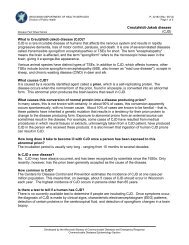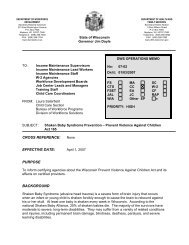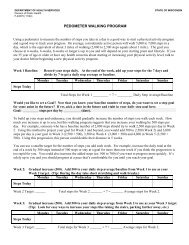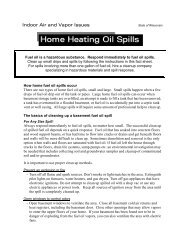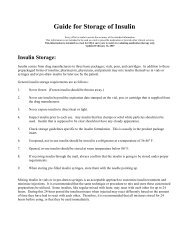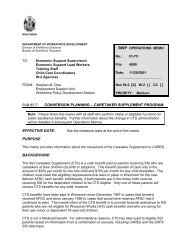F441 - Wisconsin Department of Health Services
F441 - Wisconsin Department of Health Services
F441 - Wisconsin Department of Health Services
Create successful ePaper yourself
Turn your PDF publications into a flip-book with our unique Google optimized e-Paper software.
Overview <strong>of</strong> CMS<br />
§483.65 (<strong>F441</strong>) Infection Control<br />
Surveillance Requirements<br />
Vicky Griffin, RN, BSN<br />
Nurse Consultant<br />
September 19, 2013<br />
Objective<br />
• Identify the key components <strong>of</strong> the <strong>F441</strong><br />
Infection Control Regulation related to<br />
surveillance to include;<br />
– Interpretive Guidelines<br />
– Investigative Protocol<br />
– Determination <strong>of</strong> Compliance<br />
2<br />
1
2009 CMS Surveyor<br />
Train - The -Trainer Course<br />
3<br />
Consolidation <strong>of</strong> Infection<br />
Control Regulations - 2009<br />
<strong>F441</strong><br />
F442<br />
F443<br />
F444<br />
F445<br />
<strong>F441</strong><br />
4<br />
2
<strong>F441</strong>- §483.65(a)<br />
Infection Control Program<br />
• The facility must establish an Infection Control<br />
Program under which it –<br />
1. Investigates, controls and prevents infections in<br />
the facility;<br />
2. Decides what procedures such as isolation, should<br />
be applied to an individual resident; and<br />
3. Maintains a record <strong>of</strong> incidents and corrective<br />
actions related to infections<br />
5<br />
<strong>F441</strong> - §483.65(b)<br />
Preventing Spread <strong>of</strong> Infection<br />
1. When the Infection Control Program<br />
determines that a resident needs isolation to<br />
prevent the spread <strong>of</strong> infection, the facility<br />
must isolate the resident.<br />
6<br />
Remember – When appropriate, isolate the<br />
infection and not the resident!<br />
3
<strong>F441</strong>- §483.65(b)<br />
Preventing Spread <strong>of</strong> Infection<br />
7<br />
2. The facility must<br />
prohibit employees with<br />
a communicable<br />
disease or infected skin<br />
lesions from direct<br />
contact with residents<br />
or their food, if direct<br />
contact will transmit the<br />
disease.<br />
8<br />
4
<strong>F441</strong> - §483.65(b)<br />
Preventing Spread <strong>of</strong> Infection<br />
3. The facility must require staff to wash their<br />
hands after each direct resident contact for<br />
which hand washing is indicated by<br />
accepted pr<strong>of</strong>essional practice.<br />
9<br />
Hand Hygiene is the single most<br />
effective means <strong>of</strong> preventing the<br />
spread <strong>of</strong> infection<br />
<strong>F441</strong> - §483.65(c)<br />
Linens<br />
• Personnel must<br />
10<br />
handle, store,<br />
process and<br />
transport linens as to<br />
prevent the spread <strong>of</strong><br />
infection.<br />
5
Interpretive Guidance<br />
• Contain authoritative interpretations and<br />
clarifications <strong>of</strong> statutory and regulatory<br />
requirements<br />
• Does not replace or supersede the regulation<br />
• May not be used for basis <strong>of</strong> a citation<br />
• Should not be used as basis for policies /<br />
procedures**<br />
11<br />
CMS S&C Letter 08-10 Use <strong>of</strong> Interpretive Guidance by<br />
Surveyors for Long Term Care Facilities<br />
Intent <strong>of</strong> Regulation<br />
• Assure the facility develops, implements, and<br />
maintains an Infection Prevention and Control<br />
Program in order to prevent, recognize, and<br />
control, to the extent possible, the onset and<br />
spread <strong>of</strong> infection within the facility.<br />
12<br />
6
Intent <strong>of</strong> Regulation - continued<br />
• The program will:<br />
– Perform surveillance and investigation to prevent,<br />
to the extent possible, the onset and the spread <strong>of</strong><br />
infection;<br />
– Use records <strong>of</strong> infection incidents to improve its<br />
infection control processes and outcomes by<br />
taking corrective actions, as indicated<br />
13<br />
Definitions<br />
• Community associated infections –<br />
infections present or incubating at the time <strong>of</strong><br />
admission, or generally develop within 72<br />
hours <strong>of</strong> admission<br />
14<br />
• <strong>Health</strong> care associated infections (HAIs) –<br />
infections that generally occur after 72 hours<br />
from the time <strong>of</strong> admission to a health care<br />
facility<br />
7
Definitions<br />
• Infection prevention and control program – a<br />
15<br />
program (including surveillance, investigation,<br />
prevention, control, and reporting) that<br />
provides a safe, sanitary and comfortable<br />
environment to help prevent the development<br />
and transmission <strong>of</strong> infection<br />
Definitions<br />
• Surveillance - the ongoing, systematic<br />
collection, analysis, interpretation, and<br />
dissemination <strong>of</strong> data to identify infections and<br />
infection risks, to try to reduce morbidity and<br />
mortality and to improve resident health status<br />
16<br />
8
Components <strong>of</strong> an Infection<br />
Prevention & Control Program<br />
• Program<br />
Development &<br />
Oversight<br />
• Policies &<br />
Procedures<br />
• Infection<br />
Preventionist<br />
• Surveillance<br />
• Documentation<br />
• Monitoring<br />
• Data Analysis<br />
• Communicable<br />
Disease Reporting<br />
• Education<br />
• Antibiotic Review<br />
17<br />
Interpretive Guidance<br />
Components <strong>of</strong> an Infection<br />
Prevention and Control Program<br />
• Policies, procedures, and practices which<br />
promote consistent adherence to evidencebased<br />
infection control practices;<br />
18<br />
• Surveillance, including process and outcome<br />
surveillance, monitoring, data analysis,<br />
documentation and communicable diseases<br />
reporting (as required by State and Federal<br />
law and regulation)<br />
9
Polices and Procedures<br />
• Serve as foundation<br />
<strong>of</strong> the program<br />
• Periodically reviewed<br />
& revised to ensure<br />
consistent w/ current<br />
standards <strong>of</strong> practice<br />
and address facility<br />
concerns<br />
19<br />
Surveillance<br />
20<br />
I. Assess the population<br />
II. Select outcomes or<br />
processes<br />
III. Use surveillance<br />
definitions<br />
IV. Collect surveillance data<br />
V. Calculate & analyze<br />
surveillance rates<br />
VI. Report & use surveillance<br />
information<br />
10
Surveillance<br />
• Use surveillance<br />
definitions<br />
– 2012 McGeer Criteria<br />
• Process<br />
– Collect/document<br />
symptoms <strong>of</strong> infection<br />
and compare it to case<br />
definition<br />
21<br />
Types <strong>of</strong> Surveillance<br />
• Outcome- designed<br />
to identify & report<br />
evidence <strong>of</strong> an<br />
infection<br />
• Incidence<br />
• Prevalence<br />
• Process – reviews<br />
practices directly<br />
related to care<br />
• Hand hygiene<br />
• Sterile<br />
• Use <strong>of</strong> PPE<br />
22<br />
11
Documentation<br />
• Describe types <strong>of</strong><br />
infections, healthcare<br />
acquired versus community<br />
acquired<br />
• Identify trends and patterns<br />
• Program defines how <strong>of</strong>ten<br />
and by what means data<br />
will be collected based on<br />
current standards <strong>of</strong><br />
practice<br />
23<br />
Monitoring<br />
• Residents at risk for<br />
infection<br />
• Residents with<br />
infections<br />
• Outbreaks<br />
• Implementation<br />
• Effectiveness<br />
24<br />
12
Data Analysis<br />
• Compare current<br />
surveillance data to<br />
past to detect:<br />
– Unusual or<br />
unexpected outcomes<br />
– Trends<br />
– Effective practices<br />
– Performance issues<br />
25<br />
Investigative Protocol for<br />
Infection Control<br />
• To determine if the facility has a program<br />
that;<br />
– Collects information regarding infections acquired<br />
in the facility,<br />
– Analyzes the information and;<br />
– Develops a plan <strong>of</strong> action to prevent further<br />
infections<br />
26<br />
13
Facility Record Review<br />
• Record <strong>of</strong> incidents <strong>of</strong> infection and related<br />
corrective actions to help determine whether<br />
the facility is identifying, recording, and<br />
analyzing infections<br />
27<br />
• Infection control policies to determine if they<br />
are consistent with current pr<strong>of</strong>essional<br />
standards <strong>of</strong> practice and if the policies are<br />
defined by department<br />
Facility Record Review - continued<br />
• Documentation <strong>of</strong> whether and how the<br />
infection prevention and control program<br />
collects, analyzes, and uses data and<br />
implements a program to guide all disciplines<br />
to prevent the spread <strong>of</strong> infections and<br />
identify infections in a standardized and<br />
systematic way<br />
28<br />
14
Interview – Infection Preventionist<br />
• Determine if<br />
– Facility identifies where infections are acquired<br />
(Community associated / <strong>Health</strong> care associated)<br />
– Facility collects, analyzes, and uses data related to<br />
infections, to identify and prevent the spread <strong>of</strong><br />
infections and adjusts its program (e.g., policies &<br />
procedures) as appropriate<br />
29<br />
– Program implements and monitors processes r/t<br />
hand hygiene, transmission based precautions…<br />
Criteria for Compliance<br />
• The infection control program demonstrates<br />
ongoing surveillance, recognition, investigation<br />
and control <strong>of</strong> infections to prevent the onset<br />
and the spread <strong>of</strong> infection, to the extent<br />
possible<br />
30<br />
• The facility demonstrates practices &<br />
processes consistent with infection prevention<br />
& prevention <strong>of</strong> cross contamination<br />
15
Criteria for Compliance<br />
• The facility demonstrates that it uses records<br />
<strong>of</strong> incidents to improve its infection control<br />
processes & outcomes by taking corrective<br />
action<br />
31<br />
Vicky Griffin, RN, BSN<br />
Nurse Consultant, Division <strong>of</strong> Quality Assurance<br />
819 N. 6 th Street, Room 609<br />
Milwaukee, <strong>Wisconsin</strong> 533203<br />
414 - 750 – 2741<br />
Victoria.Griffin@wi.gov<br />
32<br />
16


